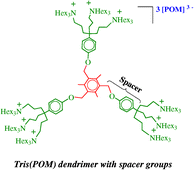Two series of dendritic compounds functionalized at the periphery with polyoxometalate (POM) units were synthesized using two synthetic strategies. The first series involved the [CpFe]+-induced functionalization of polymethylarenes, leading to dendrimers in which the dendronic tripod is directly bonded to the arene core. In the second procedure, dendrimers with a spacer group of six atoms between the arene core and the tripod units were synthesized through a coupling reaction between the phenol dendron and bromobenzyl derivatives. These polyallyl dendrimers were functionalized at the periphery to give quaternary poly-ammonium salts. Reactions of the latter with H3PW12O40 in the presence of hydrogen peroxide led to dendrimers containing {PO4[WO(O2)2]4}3− species at the periphery. These compounds are efficient catalysts for the selective oxidation of alkenes, sulfides and alcohols in an aqueous–CDCl3 biphasic system, using hydrogen peroxide as the primary oxidant. The complexes with dendritic wedges directly bonded to the arene core were found to be efficient, epoxidation catalysts that are stable if they are stored under an inert atmosphere, but they do not efficiently catalyze oxidation of alcohols. The dendritic POMs containing spacers, on the other hand, are shown to be more stable in air, they could be recycled and were efficient for the catalytic oxidation of alcohols. Recycling was carried out for the epoxidation reaction using both series of POM catalysts and yielded 50% to 85% of epoxides using the recovered catalysts, the best yields after recycling being obtained with the tris-POM catalyst built from mesitylene and containing spacers (100% conversion; yields in epoxide: first run: 90%; recycled catalyst: 85%). In the case of alcohol oxidation, the tris-POM catalyst was recycled with moderate success (92% conversion; ketone yields: first run: 75%; recycled catalyst: 50%). Among these POM catalysts, dendritic effects on the oxidation yields were found concerning the number of POM units.

You have access to this article
 Please wait while we load your content...
Something went wrong. Try again?
Please wait while we load your content...
Something went wrong. Try again?


 Please wait while we load your content...
Please wait while we load your content...